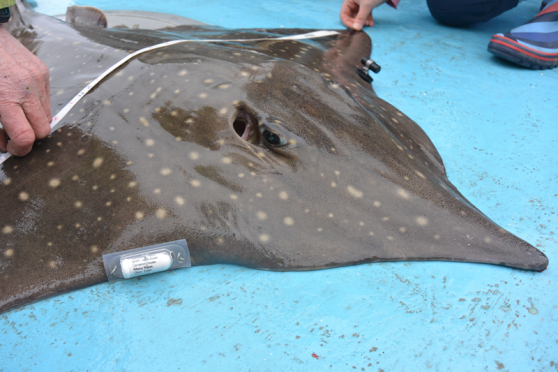Two of Scotland’s most endangered fish species are being tracked in a protected area of sea by scientists using high-tech devices.
The project is offering scientists a better understanding of how common skate and spurdog use the Marine Protected Area in Argyll.
Marine biologists from Scottish Natural Heritage (SNH) and Marine Scotland Science (MSS) are working together with help from local creel fishermen and anglers.
The Loch Sunart to the Sound of Jura MPA is designated to help protect the common skate, the world’s largest species. Skate are related to sharks and common skate can grow up to 6ft7 across and 9ft10 long.
The project team have fitted tags to 40 skate caught in the area, the largest of which weighed an impressive 98kgs.
The area is also a hotspot for spurdog, sometimes known as spiny dogfish, a small shark which grows up to 4ft11 long.
Eight of these have been tagged so far and more tagging is planned during the summer.
Both species were once common in Scottish waters, but have suffered large declines in population numbers and, now considered to be vulnerable, are included on Scotland’s list of Priority Marine Features for conservation action.
Dr Jane Dodd, who is managing the project for SNH, said: “We’re really lucky to have a wonderful range of wildlife living in our seas.
“Previous studies have shown that common skate are resident in the waters off Oban in significant numbers and the MPA was designated for their protection in 2014.
“By tracking skate in the MPA, we aim to better understand how they use the area throughout the year, which will help us to make sure that the management of the site is appropriate.”
Acoustic tags communicate with receivers positioned in the Sound of Mull, the Firth of Lorn, Loch Linnhe, the Lynn of Lorn and Loch Etive, which record each time an individual fish passes within range.
Dr James Thorburn, MSS Fish Tracking Officer, said: “Some of the skate are also fitted with Data Storage Tags (DSTs), which record the depth and water temperature every two minutes.
“DSTs provide more detail about where the fish are spending their time in the MPA, allowing us to recreate their movements.”
The white DSTs must be retrieved to access information on them. There is a £50 reward for DSTs returned to SNH.
